Going Wide | Biking the Cross New Hampshire Adventure Trail
Biking border-to-border across New Hampshire lets a native son see his state with fresh eyes.
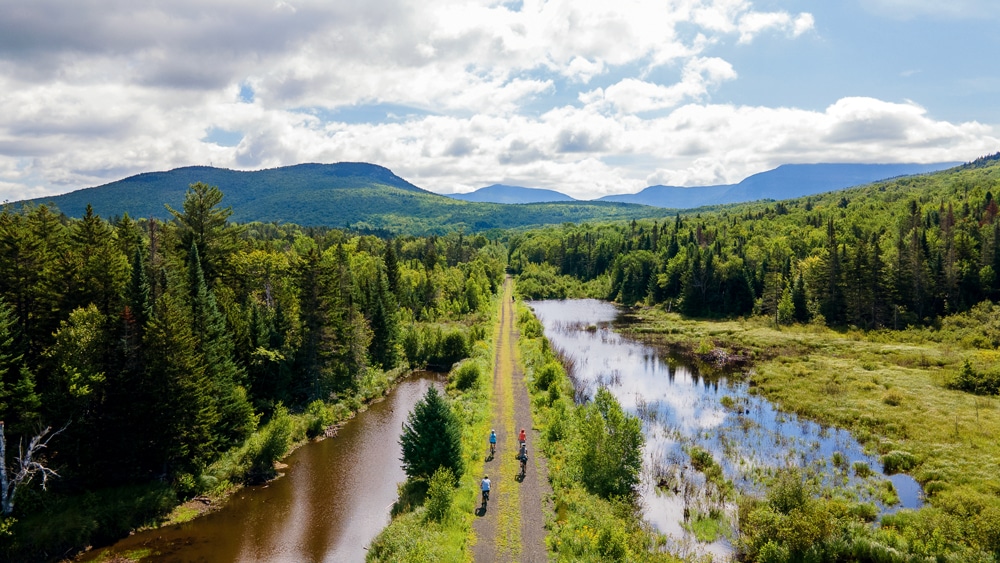
Coffee By Design | Portland, Maine
Photo Credit : Katherine Keenan
Photo Credit : Corey Hendrickson
We were about an hour into the ride, meandering along a quiet country road that traced the run of the Androscoggin River in Shelburne, New Hampshire, when the rain hit. Not a sprinkle, mind you, or even a shower, but an honest-to-God, sky-cracking-open downpour. It had closed in on us fast. One minute we were snapping photos on an old steel bridge that crossed high above the water, the next we were racing toward shelter. Any kind of shelter.
We found it at the top of a small rise, where the road bisected an old farm and a landscape that rose and gently dropped away. Under the eaves of a big red barn, my three friends and I watched the storm blow in and then just stay put. Winds swirled, rains pounded down, hail pelted the land. I looked at the others and then back out at the scene—just in time to see a birch limb shear off and crash to the ground. It seemed like an auspicious start to a three-day bikepacking trip across the northern half of the White Mountains.
But looking back on it now, I can’t think of a more perfect beginning.

Photo Credit : Corey Hendrickson
The rain eventually did let up, the skies softened, and soon we were back on our bikes, climbing and coasting our way to our evening destination, Moose Brook State Park in Gorham. But we took our sweet time getting there because, well, we could. The only programmed part of the journey was the route. The Cross New Hampshire Adventure Trail (xNHAT) is an 83-mile trek that cuts alongside rivers, drops into small towns, and spans a mix of country lanes, some busy streets and choppy logging routes, and several miles of converted rail trails.
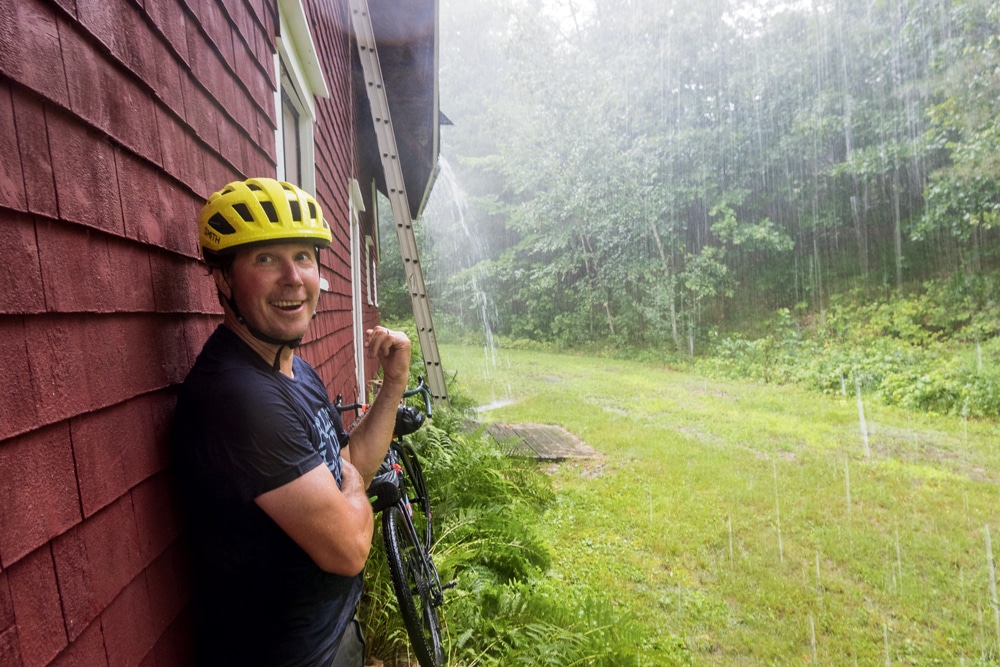
Photo Credit : Corey Hendrickson
If you have it in you, you can do the whole thing in a day. But why? Over the course of our ride, we made time for riverside breaks, explored the grounds of an old bottle factory, and relaxed with cold beers in a set of comfortable rockers at a campground outside Whitefield. We rode in the shadow of the Presidentials, cruised the dirt roads around retired farmland, and pedaled the outskirts of maybe the smallest airport I’ve ever seen. In the middle of a forgotten field, we found a plaque that commemorated the birthplace of an early-19th-century major general. In Bath we met a guy who had built a house out of a wooden train caboose. I’ve lived in New Hampshire a good chunk of my life, and I don’t think I’ve seen the breadth of my home state in one trip as I did during those three days on my bike.
It was, in other words, just the kind of experience Marianne Borowski had in mind when she designed the xNHAT three years ago. Borowski, who is 65 and a retired chemist, is most happy when she’s on her bike or talking about cycling, which is often. She’s ridden across the country; locally, she organizes a weekly community ride in her hometown of Glen and can frequently be spotted pedaling around on a green steel-frame gravel bike that her partner, Tom Matchak, hand-built for her. She’s a firm believer in the transformative powers of two-wheel travel. A statement like “When you’re on a bike you experience what’s around you in a different way” is something you might hear her say.
The idea for the xNHAT blossomed after Borowski had ridden the Cross Vermont Trail, a 90-mile trek from Burlington to Wells River that largely kept her on off-road terrain and introduced her to a few small towns she’d never visited before. When it was over, she was ready to circle back and do it again.
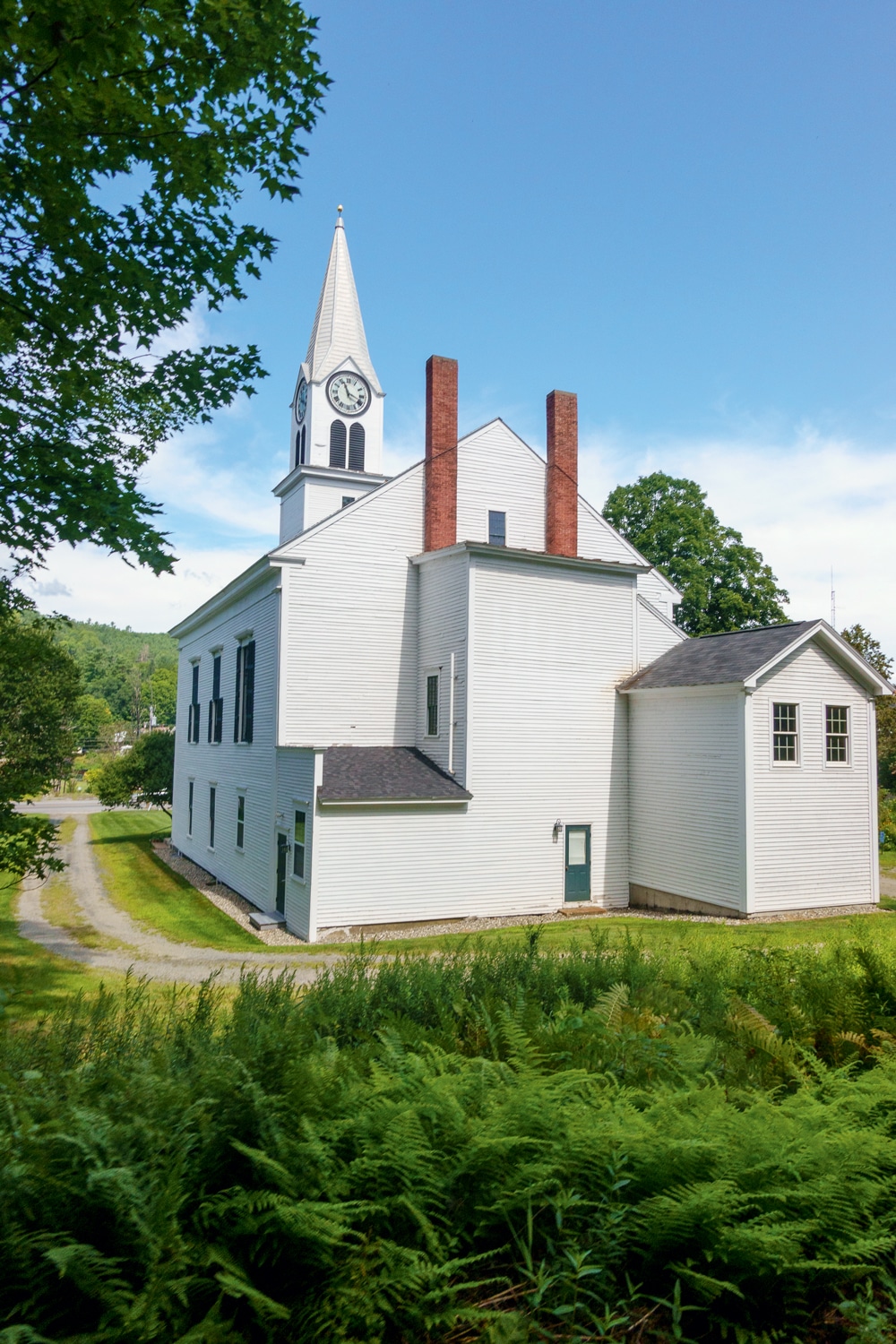
Photo Credit : Corey Hendrickson
“It’s really a depressing thing to see a ‘Trail Ends’ sign,” she says. “And when I talked to the people who put together the Vermont trail, they felt the same way. It got me thinking: Why couldn’t I pick up where they left off and make something that extends it through New Hampshire?”
In short order, the xNHAT became more than just an idea. Armed with a pencil and a bunch of maps, Borowski stitched together a patchwork of different roads and former railbeds. She built a robust website, secured a grant to produce and mail out free route maps, and designed trail patches to distribute to riders who completed the entire journey.
From Woodsville, where the Vermont trail ends, the xNHAT runs on public lands that span 11 New Hampshire towns before winding up in Bethel, Maine, just over the border. It doesn’t pack a lot of elevation gain, but the ride can be challenging, especially in the woodsy areas. Because a road bike won’t get you far and a mountain bike would be overkill for the paved sections, most cyclists opt for gravel riders.
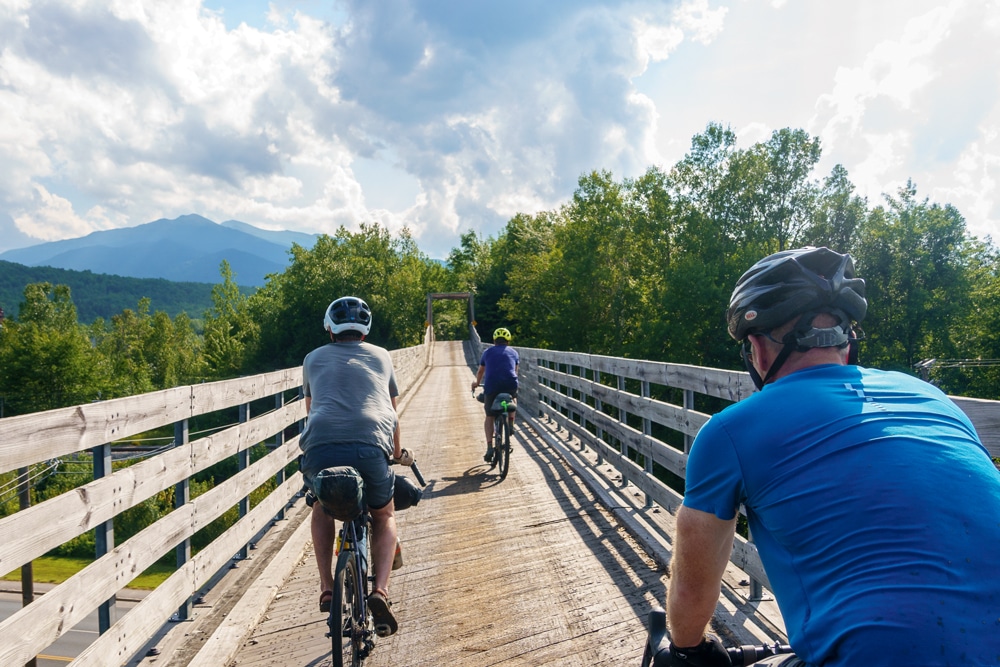
Photo Credit : Corey Hendrickson
Interest in the xNHAT has been growing. In the two years since she began marketing the ride, Borowski has mailed out more than 2,000 maps—to people as far away as Alaska and France—and distributed some 200 patches. To talk with her is to immediately notice the kind of responsibility she feels for the well-being of the trail and those who use it. When an elderly woman decided to walk the xNHAT over the course of several days, Borowski did sections of it with her. She rode parts of the trail with an older gentleman during his quest to complete it. And she’s played support crew for others who’ve used the course as a virtual event during Covid or as a part of an unofficial triathlon circuit.
During our ride, Borowski joined us on a stretch of rail trail from Gorham to Randolph. As we rode, she made mental notes on sections that needed improving and talked about her long-term goal of extending the journey deeper into Maine so that it could link to the East Coast Greenway, a route that runs all the way to Florida (“Imagine all that connectivity!” she beamed).
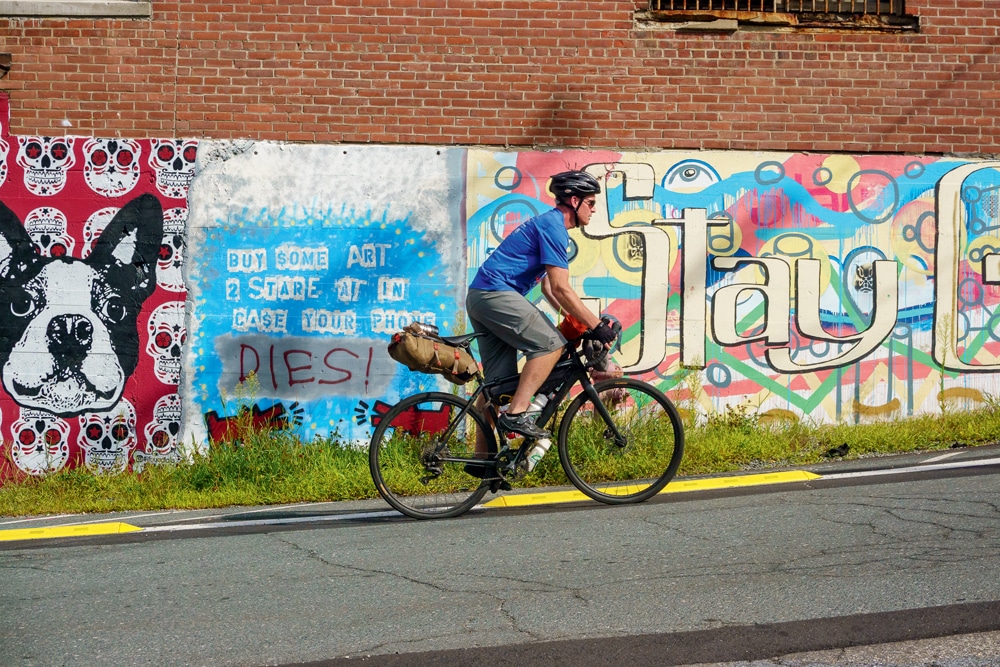
Photo Credit : Corey Hendrickson
“I want people to really see what we have up here, and cycletourism is a way for people to do that,” Borowski said. “I think it could give the towns a nice boost, and I’m hoping that as this grows and becomes more popular, we can give something to each of the communities on the trail.
“This area was made for this kind of thing. It’s not overly crowded, but there’s all this natural beauty. You bike for a bit, stop in a town, explore it, stop in a shop, maybe get something to eat. If it’s the end of the day, you can camp. Then you push on.”

Photo Credit : Corey Hendrickson
You don’t have to sleep in a tent when you bike the xNHAT. There are inns or hotels in most of the communities it passes through, as well as a newer glamping destination in Gorham, Hub North. But if you’ve got the fortitude for setting up camp at the end of a long ride, it’s worth the effort. It keeps you in the routine of the experience. What you have is exactly what you’ve packed. And what you want to pack on a bike is very little.

Photo Credit : Corey Hendrickson
This kind of forced minimalism adds to what Joe Cruz, a Williams College philosophy professor and noted bikepacker, calls the “embodiment of your presence” that comes when you’re on a bike. Cruz, whose writings and documented trips have greatly elevated bikepacking as a form of travel in recent years, sees the experience of a trail like the xNHAT as a counter to the thrill-seeking and bucket-list social sharing that have come to define much of adventure tourism.
“What I look for in a good cycling route is that it has its own story,” says Cruz, who has designed several bikepacking routes in New England, including the Green Mountain Growler, a 248-mile loop that connects 13 breweries. “It feels like it has its own rhythm and narrative, and in that story you can achieve a kind of harmony with the place, its history and its culture. There’s an alignment between you and what’s around you.”
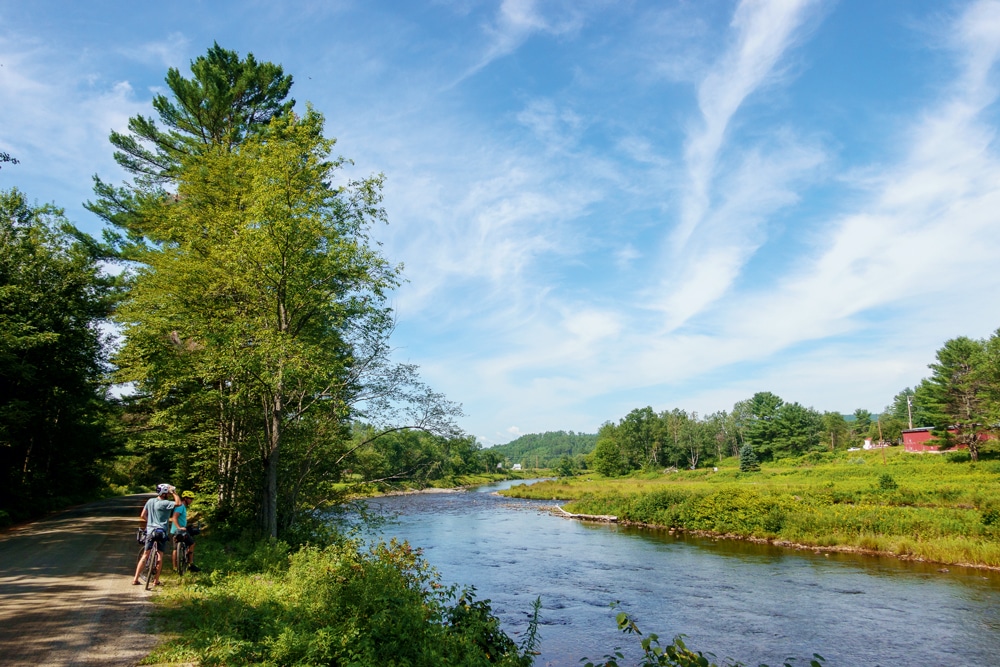
Photo Credit : Corey Hendrickson
It might sound lofty, but I like to think we attained some of that. Sometimes we rode as a group, chatting about our jobs, our kids, or the upcoming election. Other times we were spaced out in a single-file line, lost in our own thoughts or in the scenery. On a beautifully straight stretch of trail in Randolph, I imagined what it must be like in June, when both sides of the road are awash in lupines. At the former bottle plant in Gorham, we walked the overgrown grounds that had once teemed with factory life. On certain solitary stretches, my friend Brian fired up a Bluetooth speaker he’d placed in one of his bottle cages and gave our ride a soundtrack. Each night, we jumped into a pond or a pool with a kind of reckless abandon, happy about the miles we’d covered and relieved to clean off some of the day’s grime. Were we four middle-aged men on a long weekend or were we re-creating something out of Stand by Me? It was hard to tell.

Photo Credit : Corey Hendrickson
But there was also another factor at play. It was mid-August, and we were five months into the pandemic. For nearly half a year we’d been navigating a life of masks, video calls, and a locked routine of restricted motion. And then, for three short days, we got to scrap that existence. A certain serendipity was allowed to re-enter our lives. Among the rivers and mountains and all the greenery, the world looked beautiful and felt hopeful again.
Our last real stop came at the Bath Country Store, where we took a seat on the porch and dove into sandwiches and ice cream. We were just five miles from Woodsville, where our cars were parked and where another kind of journey would soon begin. I wasn’t ready to go back. In fact, I would have been more than happy to continue our ride for another few days. I thought about saying as much to the other guys. But I don’t think I needed to.
For more information on the Cross New Hampshire Adventure Trail, go to xnhat.org.






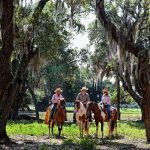

I really enjoyed this article, we love to visit the New England states.
Enjoyed the story, I felt as certain point as if I was riding with you guys. I usually road cycle, but soon I will invest in hybrid bikes (my wife) and will explore the trails. Thank you for sharing!
Try a gravel bike. So much more like your road bike :efficient pedaling, fast, light!
I love to find new places to explore